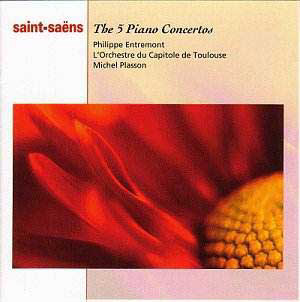And still they come! It’s not long ago that I reviewed
a Brilliant Classics bargain box of these delectable works, and at the
time I said it was entering a very crowded field, and would have to
be very special (which it wasn’t) to make any impact on the benchmark
versions. These are, should you need reminding, the marvellous Hyperion
set from Stephen Hough and Sakari Oramo, which also finds room for extra
items; the Collard/Previn bargain double on EMI, and Rogé/Dutoit
on Decca, another two-for-one that offers brilliantly idiomatic playing
and excellent recording quality. There is also a bargain ASV set from
Angela Brownridge which I haven’t heard, but which has received reasonable
praise and is in modern sound.
Sad to say, much as I admire the artists on this new
budget re-issue from Sony Classical, I cannot find enough positive things
throughout the set to recommend it over the rivals. For a start, it
suffers from a brightly lit and oddly balanced recording. Although Sony
give us no details of age or venue, the amount of tape hiss at the start
tends to suggest an analogue source. This needn’t be a bad thing, of
course, but with such a forward balance, and spotlighting of various
instruments, it soon becomes tiresome. Entremont can sometimes be an
aggressively muscular player, which suits some music, but here it simply
sounds unnecessarily harsh. Add to that a piano that is very brightly
voiced, out of tune in places, and sounding far too close for comfort,
and the results are not pretty. The virtuosity in these works needs
to sound effortless, and in places I felt Entremont was struggling slightly
with his technique. The delectable scherzando second movement
from the famous G Minor Concerto, shows some uneven scale passages,
and where one should have throwaway bravura (as with the others), here
things sound a little laboured. The gorgeous slow movement from the
D Major Concerto (No.1) is spoilt, for me, by lumpy phrasing
in the piano’s triplet interpolations, which instead of sounding distant
and exotic, are perfunctory and leaden. The E Flat Concerto (No.3)
is unnecessarily split between the two discs, which, according to my
calculations, could have just been accommodated on the first disc, leaving
room (as with the rivals) for useful fill-ups. To be sure, there are
things to enjoy on the way. I like Plasson’s phrasing of the orchestral
accompaniment in the first movement of the C Minor Concerto (No.4),
which boasts some lovely string playing. The cod orientalism of the
5th Concerto (the so-called ‘Egyptian’) is nicely
conveyed, but I miss the sheer artistry of a Hough or Rogé, who
play this music as if it were the greatest ever written.
As mentioned above, it seems to be an unfortunate combination
at work here. If the players had been treated to a more sympathetic,
warmer acoustic with a better balance, the fierceness of some of the
playing may have been less noticeable. As it is, the awful piano sound
(where on earth was the tuner?) is totally unacceptable. My advice is,
spend a bit more on any of the others, and you will get far more from
these life-enhancing works.
Tony Haywood


